Yongri Piao
P3Net: Progressive and Periodic Perturbation for Semi-Supervised Medical Image Segmentation
May 21, 2025Abstract:Perturbation with diverse unlabeled data has proven beneficial for semi-supervised medical image segmentation (SSMIS). While many works have successfully used various perturbation techniques, a deeper understanding of learning perturbations is needed. Excessive or inappropriate perturbation can have negative effects, so we aim to address two challenges: how to use perturbation mechanisms to guide the learning of unlabeled data through labeled data, and how to ensure accurate predictions in boundary regions. Inspired by human progressive and periodic learning, we propose a progressive and periodic perturbation mechanism (P3M) and a boundary-focused loss. P3M enables dynamic adjustment of perturbations, allowing the model to gradually learn them. Our boundary-focused loss encourages the model to concentrate on boundary regions, enhancing sensitivity to intricate details and ensuring accurate predictions. Experimental results demonstrate that our method achieves state-of-the-art performance on two 2D and 3D datasets. Moreover, P3M is extendable to other methods, and the proposed loss serves as a universal tool for improving existing methods, highlighting the scalability and applicability of our approach.
DefMamba: Deformable Visual State Space Model
Apr 08, 2025Abstract:Recently, state space models (SSM), particularly Mamba, have attracted significant attention from scholars due to their ability to effectively balance computational efficiency and performance. However, most existing visual Mamba methods flatten images into 1D sequences using predefined scan orders, which results the model being less capable of utilizing the spatial structural information of the image during the feature extraction process. To address this issue, we proposed a novel visual foundation model called DefMamba. This model includes a multi-scale backbone structure and deformable mamba (DM) blocks, which dynamically adjust the scanning path to prioritize important information, thus enhancing the capture and processing of relevant input features. By combining a deformable scanning(DS) strategy, this model significantly improves its ability to learn image structures and detects changes in object details. Numerous experiments have shown that DefMamba achieves state-of-the-art performance in various visual tasks, including image classification, object detection, instance segmentation, and semantic segmentation. The code is open source on DefMamba.
CNN-Transformer Rectified Collaborative Learning for Medical Image Segmentation
Aug 27, 2024



Abstract:Automatic and precise medical image segmentation (MIS) is of vital importance for clinical diagnosis and analysis. Current MIS methods mainly rely on the convolutional neural network (CNN) or self-attention mechanism (Transformer) for feature modeling. However, CNN-based methods suffer from the inaccurate localization owing to the limited global dependency while Transformer-based methods always present the coarse boundary for the lack of local emphasis. Although some CNN-Transformer hybrid methods are designed to synthesize the complementary local and global information for better performance, the combination of CNN and Transformer introduces numerous parameters and increases the computation cost. To this end, this paper proposes a CNN-Transformer rectified collaborative learning (CTRCL) framework to learn stronger CNN-based and Transformer-based models for MIS tasks via the bi-directional knowledge transfer between them. Specifically, we propose a rectified logit-wise collaborative learning (RLCL) strategy which introduces the ground truth to adaptively select and rectify the wrong regions in student soft labels for accurate knowledge transfer in the logit space. We also propose a class-aware feature-wise collaborative learning (CFCL) strategy to achieve effective knowledge transfer between CNN-based and Transformer-based models in the feature space by granting their intermediate features the similar capability of category perception. Extensive experiments on three popular MIS benchmarks demonstrate that our CTRCL outperforms most state-of-the-art collaborative learning methods under different evaluation metrics.
CriDiff: Criss-cross Injection Diffusion Framework via Generative Pre-train for Prostate Segmentation
Jun 20, 2024



Abstract:Recently, the Diffusion Probabilistic Model (DPM)-based methods have achieved substantial success in the field of medical image segmentation. However, most of these methods fail to enable the diffusion model to learn edge features and non-edge features effectively and to inject them efficiently into the diffusion backbone. Additionally, the domain gap between the images features and the diffusion model features poses a great challenge to prostate segmentation. In this paper, we proposed CriDiff, a two-stage feature injecting framework with a Crisscross Injection Strategy (CIS) and a Generative Pre-train (GP) approach for prostate segmentation. The CIS maximizes the use of multi-level features by efficiently harnessing the complementarity of high and low-level features. To effectively learn multi-level of edge features and non-edge features, we proposed two parallel conditioners in the CIS: the Boundary Enhance Conditioner (BEC) and the Core Enhance Conditioner (CEC), which discriminatively model the image edge regions and non-edge regions, respectively. Moreover, the GP approach eases the inconsistency between the images features and the diffusion model without adding additional parameters. Extensive experiments on four benchmark datasets demonstrate the effectiveness of the proposed method and achieve state-of-the-art performance on four evaluation metrics.
MFNet: Multi-filter Directive Network for Weakly Supervised Salient Object Detection
Dec 03, 2021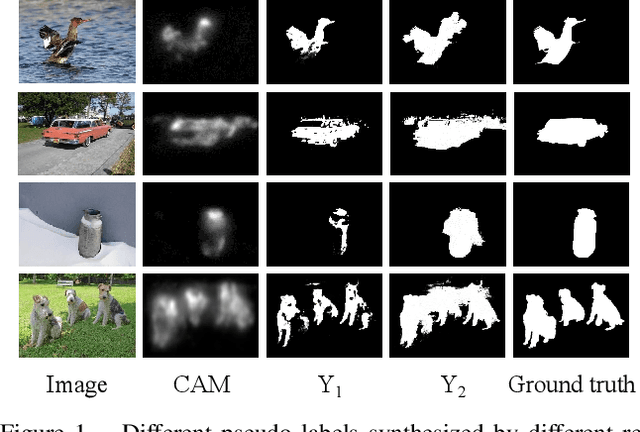

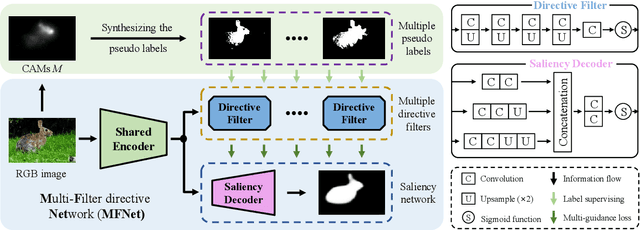

Abstract:Weakly supervised salient object detection (WSOD) targets to train a CNNs-based saliency network using only low-cost annotations. Existing WSOD methods take various techniques to pursue single "high-quality" pseudo label from low-cost annotations and then develop their saliency networks. Though these methods have achieved good performance, the generated single label is inevitably affected by adopted refinement algorithms and shows prejudiced characteristics which further influence the saliency networks. In this work, we introduce a new multiple-pseudo-label framework to integrate more comprehensive and accurate saliency cues from multiple labels, avoiding the aforementioned problem. Specifically, we propose a multi-filter directive network (MFNet) including a saliency network as well as multiple directive filters. The directive filter (DF) is designed to extract and filter more accurate saliency cues from the noisy pseudo labels. The multiple accurate cues from multiple DFs are then simultaneously propagated to the saliency network with a multi-guidance loss. Extensive experiments on five datasets over four metrics demonstrate that our method outperforms all the existing congeneric methods. Moreover, it is also worth noting that our framework is flexible enough to apply to existing methods and improve their performance.
To be Critical: Self-Calibrated Weakly Supervised Learning for Salient Object Detection
Sep 04, 2021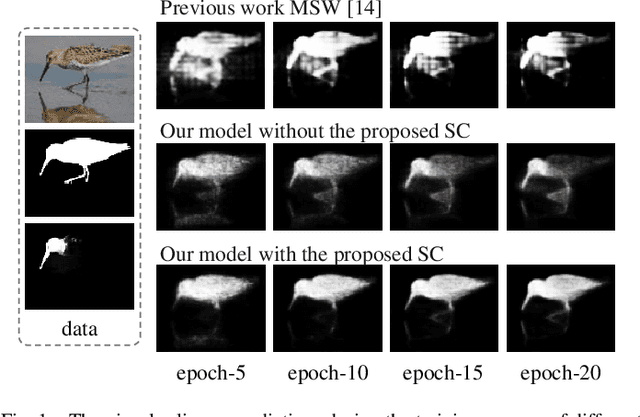

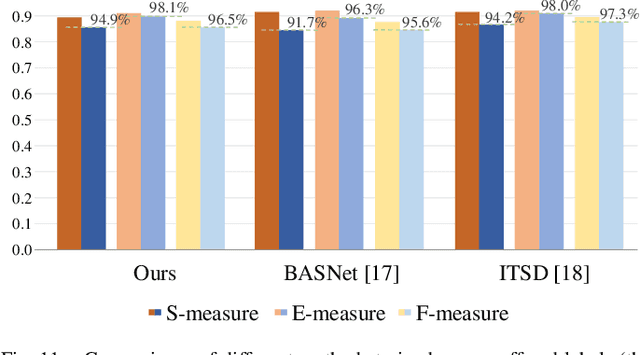

Abstract:Weakly-supervised salient object detection (WSOD) aims to develop saliency models using image-level annotations. Despite of the success of previous works, explorations on an effective training strategy for the saliency network and accurate matches between image-level annotations and salient objects are still inadequate. In this work, 1) we propose a self-calibrated training strategy by explicitly establishing a mutual calibration loop between pseudo labels and network predictions, liberating the saliency network from error-prone propagation caused by pseudo labels. 2) we prove that even a much smaller dataset (merely 1.8% of ImageNet) with well-matched annotations can facilitate models to achieve better performance as well as generalizability. This sheds new light on the development of WSOD and encourages more contributions to the community. Comprehensive experiments demonstrate that our method outperforms all the existing WSOD methods by adopting the self-calibrated strategy only. Steady improvements are further achieved by training on the proposed dataset. Additionally, our method achieves 94.7% of the performance of fully-supervised methods on average. And what is more, the fully supervised models adopting our predicted results as "ground truths" achieve successful results (95.6% for BASNet and 97.3% for ITSD on F-measure), while costing only 0.32% of labeling time for pixel-level annotation.
Learning Multi-modal Information for Robust Light Field Depth Estimation
Apr 13, 2021

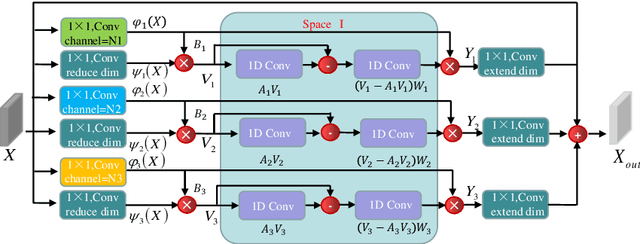

Abstract:Light field data has been demonstrated to facilitate the depth estimation task. Most learning-based methods estimate the depth infor-mation from EPI or sub-aperture images, while less methods pay attention to the focal stack. Existing learning-based depth estimation methods from the focal stack lead to suboptimal performance because of the defocus blur. In this paper, we propose a multi-modal learning method for robust light field depth estimation. We first excavate the internal spatial correlation by designing a context reasoning unit which separately extracts comprehensive contextual information from the focal stack and RGB images. Then we integrate the contextual information by exploiting a attention-guide cross-modal fusion module. Extensive experiments demonstrate that our method achieves superior performance than existing representative methods on two light field datasets. Moreover, visual results on a mobile phone dataset show that our method can be widely used in daily life.
Dynamic Fusion Network For Light Field Depth Estimation
Apr 13, 2021



Abstract:Focus based methods have shown promising results for the task of depth estimation. However, most existing focus based depth estimation approaches depend on maximal sharpness of the focal stack. Out of focus information in the focal stack poses challenges for this task. In this paper, we propose a dynamically multi modal learning strategy which incorporates RGB data and the focal stack in our framework. Our goal is to deeply excavate the spatial correlation in the focal stack by designing the spatial correlation perception module and dynamically fuse multi modal information between RGB data and the focal stack in a adaptive way by designing the multi modal dynamic fusion module. The success of our method is demonstrated by achieving the state of the art performance on two datasets. Furthermore, we test our network on a set of different focused images generated by a smart phone camera to prove that the proposed method not only broke the limitation of only using light field data, but also open a path toward practical applications of depth estimation on common consumer level cameras data.
DUT-LFSaliency: Versatile Dataset and Light Field-to-RGB Saliency Detection
Dec 30, 2020

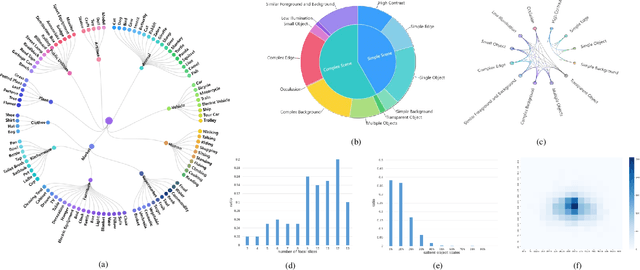

Abstract:Light field data exhibit favorable characteristics conducive to saliency detection. The success of learning-based light field saliency detection is heavily dependent on how a comprehensive dataset can be constructed for higher generalizability of models, how high dimensional light field data can be effectively exploited, and how a flexible model can be designed to achieve versatility for desktop computers and mobile devices. To answer these questions, first we introduce a large-scale dataset to enable versatile applications for RGB, RGB-D and light field saliency detection, containing 102 classes and 4204 samples. Second, we present an asymmetrical two-stream model consisting of the Focal stream and RGB stream. The Focal stream is designed to achieve higher performance on desktop computers and transfer focusness knowledge to the RGB stream, relying on two tailor-made modules. The RGB stream guarantees the flexibility and memory/computation efficiency on mobile devices through three distillation schemes. Experiments demonstrate that our Focal stream achieves state-of-the-arts performance. The RGB stream achieves Top-2 F-measure on DUTLF-V2, which tremendously minimizes the model size by 83% and boosts FPS by 5 times, compared with the best performing method. Furthermore, our proposed distillation schemes are applicable to RGB saliency models, achieving impressive performance gains while ensuring flexibility.
Accurate RGB-D Salient Object Detection via Collaborative Learning
Jul 23, 2020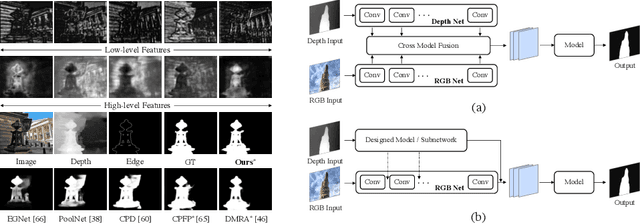

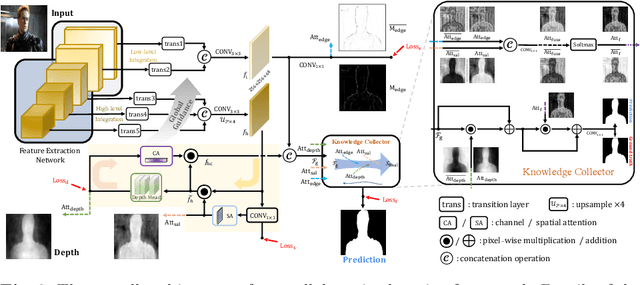

Abstract:Benefiting from the spatial cues embedded in depth images, recent progress on RGB-D saliency detection shows impressive ability on some challenge scenarios. However, there are still two limitations. One hand is that the pooling and upsampling operations in FCNs might cause blur object boundaries. On the other hand, using an additional depth-network to extract depth features might lead to high computation and storage cost. The reliance on depth inputs during testing also limits the practical applications of current RGB-D models. In this paper, we propose a novel collaborative learning framework where edge, depth and saliency are leveraged in a more efficient way, which solves those problems tactfully. The explicitly extracted edge information goes together with saliency to give more emphasis to the salient regions and object boundaries. Depth and saliency learning is innovatively integrated into the high-level feature learning process in a mutual-benefit manner. This strategy enables the network to be free of using extra depth networks and depth inputs to make inference. To this end, it makes our model more lightweight, faster and more versatile. Experiment results on seven benchmark datasets show its superior performance.
 Add to Chrome
Add to Chrome Add to Firefox
Add to Firefox Add to Edge
Add to Edge